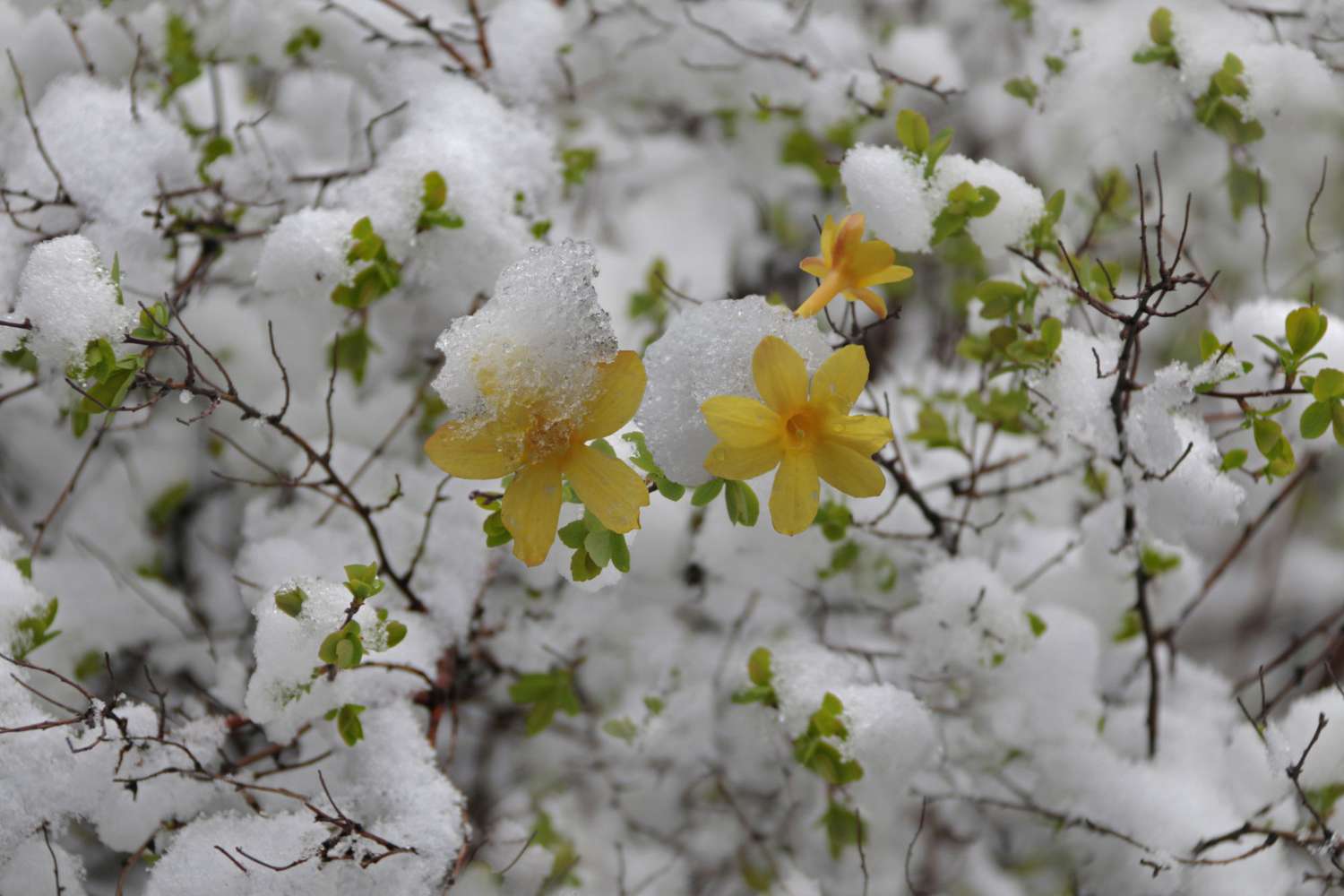Newbie gardeners, listen up! This beautiful plant blooms insanely in the winter, grows easily, and (for some strange reason) isn’t found in any of your neighbor’s gardens.
Native to China, winter jasmine (Jasminum nudiflorum) is a vining, deciduous shrub that grows three to four feet high and twice as wide. It will climb a trellis, but it looks best cascading over the top of a retaining wall or tumbling down a bank or hillside. Its arching, willowy stems root wherever they touch the ground, forming a thick brow of leaves and stems.
Hundreds of waxy, bright-yellow flowers open all along the stems in the dead of winter. While not as elaborate as forsythia (a shrub it’s often confused with), its blossoms appear over a more extended period. Another advantage this shrub enjoys over its rival—its stems stay green year-round, bringing even more color to the winter garden.
About Winter Jasmine
The winter jasmine grows best in USDA Zones 6-10 and blooms mid-winter or early spring. These beautiful, deciduous shrubs attract butterflies, are pet-friendly, and the care is easy. Winter jasmine is fast-growing and spreads, making it a good plant to train to grow over a trellis or use as ground cover.
The flowers contain four or five petals in a star formation, growing around one to three inches wide. Unlike other jasmine varieties, this shrub is unscented. Here’s more about the winter jasmine.
How to Grow and Care for Winter Jasmine
Soil and Sunlight
For best results, plant winter jasmine in an area with well-drained soil that receives full sun—even in the winter. Full or partial sunlight is needed, so plant winter jasmine in an area that receives two to six (or more) hours of direct sunlight.
In addition to well-drained soil, winter jasmine should have moist soil but still feel dry to the touch. Consider adding all-purpose plant food to the soil for extra nutrition. Soil quality doesn’t significantly impact winter jasmine’s growth, but adding some compost may be beneficial.
Water and Fertilizer
Water it regularly in the summer to maintain this plant—at least once a week, or more in extreme heat. You should continue to water winter jasmine, even when the temperatures drop. It’s a cold-hardy shrub that can thrive in temperatures down to 5°Fahrenheit.
Fertilize winter jasmine in the spring after the blooms have faded. A slow-release fertilizer added to the plant’s base will help stimulate growth and encourage more flowers to show—Fertilizers such as mycorrhizal fungi or compost work well with this shrub.

Pruning
If you see a decline in winter blooms, prune the stems to a few inches above the ground to stimulate new growth. To train winter jasmine to grow over a trellis, prune it regularly, but otherwise, allow growth to spill over a low-hanging wall or in a large pot.
Since winter jasmine spreads, it makes an excellent ground cover but will also extend to unwanted areas if you don’t prune roots back to their intended space. Pruning will help control the growth but may also impact the flower showing the following year.
Common Pests and Plant Diseases
Winter jasmine is relatively disease-resistant, and deer usually resist this shrub. It is also not highly susceptible to drought. However, insects and plant diseases, including aphids and mealybugs, can impact winter jasmine. Aphids, also known as greenfly or blackfly, thrive in warm conditions and are sap-suckling bugs. Mealybugs are also sap-suckling bugs that release a white secretion on the leaves of plants. This white, waxy residue can cause fungus to grow on winter jasmine leaves and reduces direct sunlight. Treat aphids and mealybug infestations by spraying an organic solution and wiping down the shrub’s leaves.
How To Plant Winter Jasmine
If you want your winter jasmine flowers to bloom during the winter season, you should plant them in the spring. If you are growing winter jasmine to provide some extra color in your winter garden but not necessarily flower blooms, you can wait until the fall to plant. Winter jasmine will tolerate all seasons, so it is considered a deciduous, perennial plant.
Winter jasmine grows fast, so you won’t have to wait long to see its bloom. Start with plants from your garden center in one-gallon, two, or three-gallon pots. Space them three feet apart. You should plant it level with the root balls meeting the top of the soil.
Propagating Winter Jasmine
To propagate winter jasmine, start by taking cuttings and planting them into a well-draining pot. This fast-growing plant naturally develops new roots and offshoots. Make sure to maintain proper sunlight exposure, well-draining or moist soil, and consistent watering.
Was this page helpful?
Thanks for your feedback!
Tell us why!